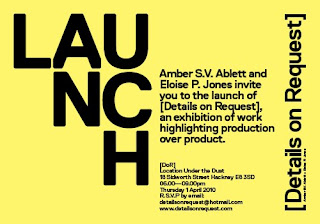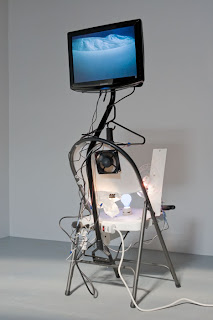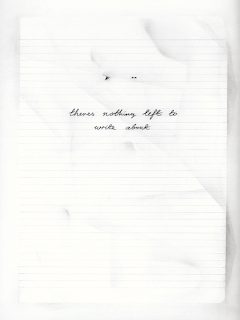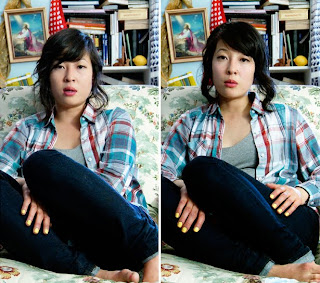Thursday 25 March 2010
[Deets on the Streets]
BRISTOL- ARNOLFINI
Firstly, Janek Simon, a Polish artist who had been artist in residence at the Arnolfini in 2008/9. The exhibition attempts to understand globalization and the shrinking of our world. Taking Paul Virilio’s idea of the end of Geography as a starting point Simon looks at key locations in the history of the Trans Atlantic Slave Trade Triangle of West Coast Africa, the Caribbean and Bristol. The end of Geography looks at the problems that face us due to the increase in communication across the world resulting in the loss of cultural differences.
This exhibition was of particular interest to me as my family comes from Trinidad, a Caribbean island where the majority of the population can be traced by to West Africa via the slave trade. Simon used a map of Trinidad in his piece 'Time-space compression of Trinidad' 2010, in which he uses a wooden sculpture to show the actual time distances between places on the map. I felt that it was very honest for a Bristol gallery to acknowledge the cities involvement with the shipping of slaves and their produce.
In the last gallery was the interactive installation ‘Carpet Invader’ 2002. The work emphasizes the idea of world becoming one; a prayer mat turned computer game. Of course, we played on it and were easily distracted by the lights, explosions and desire to win the game and it was only when we came away that we looked back on the concept of the piece of work and what we had been doing.
Also on show was work by Imogen Stidworthy. Her video, sound works and installations look at speech, language and translation.
‘Get here’ 2006, a commonly heard Liverpudlian phrase, was played from multiple speakers voiced by multiply voices into a central space. Hearing one phrase highlighted the differences in all our voices. Our accents give us a geographically identity but our individual tones and pitch give us our personal identity.
‘Topography of a Voice’ 2008/9 turned this personal identity into some thing tangible. What makes our voice recognizable as us can be analysed, dissected and broken down. I was interested in the way the work turned sound into something visual.
In ‘I Hate’ 2007, I noted how speech and communication is not just limited to our voice. After the art photographer Edward Woodman lost his ability to speak because of a cycling accident he began to photograph the building of the Eurostar terminal at King’s Cross. In video works I was drawn to the way in which he had to rely on the use of his hands and gestures to aid his spoken communication.
This reminded me of something I had read in Milan Kundera’s ‘Immortality’ on the importance of the gesture:
‘Without the slightest doubt, there are far fewer gestures in the world than there are individuals. That finding leads us to a shocking conclusion: a gesture is more individual than an individual. We could put it in the form of an aphorism: many people, few gestures.’
In ‘Barrabackslarrabang’ 2009/10, a video piece, again our attention is drawn to the gestures of the subjects. Stidworthy’s video work looks at Liverpool backslang, a type of code used primarily by the criminal classes to protect themselves from being understood by others- namely the law.
www.arnolfini.org.uk/
[Amber S. V. Ablett]
Wednesday 24 March 2010
[space]
Nick Laessing: LIGHT | READING
19th March - 17th April 2010
LIGHT | READING is the product of Nick Laessing’s PERMACULTURES residency at [space] Studios, exploring and researching the free-energy movement.
PERMACULTURES residency offers an environment to discuss and explore the relationship of sustainability in regard to the creative and the ecology of art and culture.
A number of scientists, including the inventor Nikola Tesla, thought it to be possible to source free-energy from our atmosphere. During Laessing’s residency radio interviews were sourced along with primary reasearch to explore the development and progress of this philosophy.
The exhibition presents Nick Laessing’s reconstruction of a radiant engeriser to power the lighting and sound equipment that is used in the exhibition. The physical experiments are presented along with the research to highlight our environmental situation and to gain a better understanding of the ethos surrounding alternative energy.

Adam Thomas: Colourless Green Ideas Sleep Furiously
19th March - 17th April 2010

Guestroom: The Librarians
19th March - 17th April 2010

Ben Woodeson: Foyer Space
19th March - 17th April 2010
Foyer Space consisted of a public sign stating that a chemical spillage had occurred, and to be aware that you/the viewer may suffer serious symptoms.

www.spacestudios.org.uk
[Eloise P. Jones]
Tuesday 23 March 2010
Amber S.V.Ablett & Eloise P. Jones Invite You To The Launch Of [DoR]

Amber S. V. Ablett and Eloise P. Jones would like to invite you to the launch exhibition of [Details on Request] on Thursday the 1st April 2010 from 6-9pm.
Featuring work by:
Airimages: www.airimages.org
David Butler:
Laurie Lax:
Liberty Rowley & Mark James: www.libertyrowley.blogspot.com
Matthew Kay: www.matthewjameskay.com
Matthew Mackisack:
Rie Hale: www.riehale.com
Victoria Karlsson
and an introductory installation by [DoR]. Using a variety of different art forms, including performance, sculpture, video and drawing, these artists all create work that places emphasis on their own production.
Following the exhibition please join us for the [DoR] Afterparty for music and drinks, from 9-12pm.
Please RSVP to:
detailsonrequest@hotmail.com
CAN'T WAIT TO SEE YOU THERE!!!!
Amber & Eloise xx
Saturday 13 March 2010
ROAMING ROOMS- CAROLYN BUNT
ROAMING ROOMS- ANDREA MEDJESI- JONES
http://www.andreamedjesijones.com/Paintings.html
At Seventeen Gallery we were given a short talk by Cassis from the Gallery about Graham Dolphin’s work, giving me a chance to re-visit the work and learn more about it. See the previous post for more information on ‘Burn Away Fade Out’.
[Amber. S. V. Ablett]
ROAMING ROOMS- AMY GREEN
ROAMING ROOMS- JOHN STARK
Yesterday, I was very lucky to be given the chance to join Sandi Macrae on Roaming Rooms tour of artist’s studios and galleries in East London. It was great to be given the opportunity to hear artists talk so openly about their work and be part of a group with a wide range of viewpoints and opinions.
Wednesday 10 March 2010
MATT ROBERTS ARTS VIDEO SALON 10

Last Thursday, [DoR] attended the opening of the Salon Video exhibition at Matt Roberts Arts. Matt’s compact exhibition space was transformed into a technological hive and packed with people but [DoR] was very impressed with the work that we saw behind people’s heads and over their shoulders. In particular, Sai Hua Juan’s Line Drawing.
We look forward to Part Two of the exhibition.
[Amber. S. V. Ablett]
SIMON MORSE at GOODEN GALLERY


In the Gooden Gallery next door, we were again presented with a room of mechanical objects but Simon Morse’s ‘prototypes’ were without function. Morse’s work mixes ‘languages and forms, absurdities and profanities [and] the works reveal a vision of ideation and production pushed to the boundaries of un-meaning by some overwhelming runaway imperative’ (????)
Anyway, [DoR] cannot help but feel that the works might have been more successfully shown as an installation, hidden away to be found and questioned unexpectedly rather than being displayed in an uninventive traditional way, as we would view a painting exhibition in a national institution. Once [DoR] had seen the first five of these interesting and provocative items….we had seen them all. Shame.
25A Vyner Street, London, E2 9DG
www.goodengallery.com/exhibitions/09_Trees_Mountain/
[Amber. S. V. Ablett]
PEEPING TOM at VEGAS

At Vegas, [Details on Request] were pleased to see some work by the artist partnership Coleman & Hogarth. Whilst at University Coleman & Hogarth gave a talk on their work (as part of the dreaded ACAPS module of our degree). [DoR] became very interested in their work that crosses performance, events and film. Their work was being shown as part of a group show curated by Keith Coventy alongside work by Tracy Emin, Jeremy Deller and (the fantastic) Fionna Banner. ‘Peeping Tom’ looks at the artist’s role in seeing the overseen and brought together a vast selection of provocative and confrontational work.

Vegas Gallery
45 Vyner Street
E2 9DQ
London
www.vegasgallery.co.uk
[Amber. S. V. Ablett]
SENSESCAPES at NETTIE HORN

Another inspiring exhibition at Nettie Horn. In ‘Sensescapes’ work by Benoit Broisat, Laura Buckly, Ian Burns and Sinta Werner looks at the visual and mental relationship we have with the world around us. The exhibition ‘will focus on the status of the image through the use of technological mediums such as video, photography and works based on mechanised elements’. Ian Burn’s sculptures functioned to distort the way in which we see. A man made plastic bag is viewed through a monitor as a beautiful glacial landscape and in Broisat’s video piece ‘1950dd’ we see the surface of a painting as a bird’s eye view of a landscape coupling what we see as traditional art with new media. Although the use of new media, video works, performance etc. are often seen as cold or haughty Sensescapes shows the warmth and beauty that are being created with these mediums.
25B Vyner Street, London, E2 9GD
www.nettiehorn.com/Sensescapes.htm
[Amber. S. V. Ablett]
ATHI-PATRA RUGA at FRED

At Fred, we were welcomed with a photograph of naked black man with a distorted Elvis mask on. This was a piece of work from the solo show by South African artist Athi-Patra Ruga. His photographs, as well as being challenging and confronting questions of politics, xenophobia and racism also have the stylised perfection of fashion photography, in particular the ethereal images of a model photographed amongst sheep in what looks like a typical misty English field. The difficult issues tackled in Ruga’s work are emphasised more so in his tapestries when we later found out that they were made traditionally by local crafts women in South Africa.
GRAHAM DOLPHIN at SEVENTEEN GALLERY

[Details on Request] often find themselves drawn to work that is labour intensive whilst verging on pointless. Nothing makes a time consuming activity more worthless than when it can be completed more swiftly another way and yet this is what makes the outcome the more prized.
And so it was with great interest and eager anticipation that [DoR] went to Seventeen Gallery to see Graham Dolphin’s pencil drawn reproductions of four suicide notes by cult musicians. These notes left by Elliot Smith, Kurt Cobain, Ian Curtis and Phil Ochs are widely recognised but by hand drawing each one Dolphin re-values them and shows his personal appreciation of them and their writers. In fact three out of the four notes have been take from attributed myths surrounding the musicians deaths. They have been taken from rumours and stories which surround the icons deaths; the story goes that Elliot Smith argued with his girlfriend in a hotel, stabbed himself and left a message on a post-it note on the mirror; Phil Ochs hung himself with a note saying ‘There is nothing left to write about’ pinned to his chest and the envelope with the name Deborah was taken from the last shot of the film Control about Ian Curtis. Only Kurt Cobain’s letter to Buddah is one that can be read on the Internet. A suicide note is probably more private than a love letter and yet we are presented with them as part of an exhibition, both appealing and repulsing the viewer. These dual reactions are mirrored in the concept of the exhibition as a whole- our fascination with death and even more so the detached and somewhat imitated grief with celebrity death that is can be personal without having any kind of relationship with the person. Dolphin has also recreated an exact copy of the bench outside Kurt Cobain’s house in Seattle, distressing a new bench with three years of fan’s messages, candles and friendship bracelets in a couple of months with in his studio. He copied six replicas of a bust that was on Jim Morrison’s grave in Paris from photographs showing how it became worn away with graffiti and eventually stolen from the site.
Monday 1 March 2010
CANDICE BREITZ: FACTUM at WHITE CUBE HOXTON

Film of any kind, whether high art or a rom-com is at its most successful when it captivates the viewer so time passes unaware. So that [DoR] was asked to leave White Cube Hoxton after spending minutes, hours (…more?) in front of Candice Breitz’s split screen video work Factum speaks volumes about their opinion of it. The main gallery in the Hoxton gallery has be changed into a maze of screen rooms, far from a white cube, they have made the space into a too inviting area to get lost in front of the work.
Factum is an exhibition of video works shot in Toronto, Canada. The videos are comprised of interviews that Breitz has conducted with sets of twin (and one set of triplets). The films have been edited so that the siblings appear to be having a conversation with each other. They are dressed in the same clothes making the difficulty with telling them apart and the problems of identity and individualism even harder.
The name Factum is taken from Robert Rauschenberg’s almost identical paintings Factum I and Factum II (1957) and the videos are shown like a diptych reflecting this influence.
To watch the interviewees talking about the problems of being two people but feeling like one person is fascinating. It is heartbreaking to hear the twins imagining the freedom of not being a twin and seeing the attraction and repulsion this causes. One twin refers to the other as her soul mate but also wishes that she could have been born without a twin.
Factum looks at the way that twins struggle to differentiate themselves in a society that values the individual, something that can be applied to any of us.

![[Details on Request]](http://1.bp.blogspot.com/_tvc3MiCIG7U/TPqR9siGmGI/AAAAAAAAAsc/ky-TDXBCkcw/S729/DOR01.jpg)











